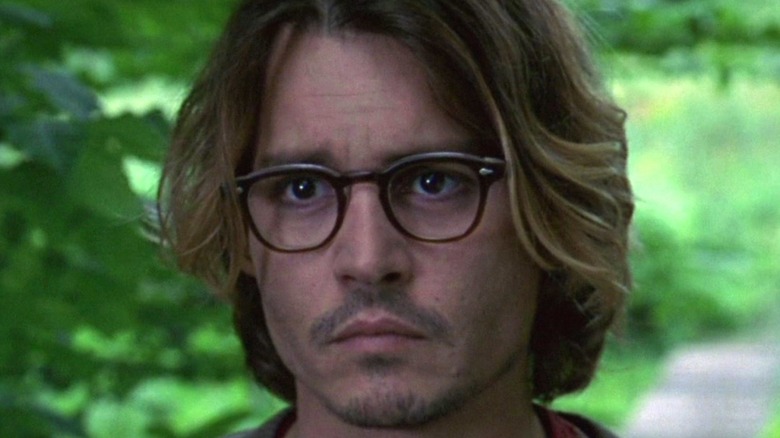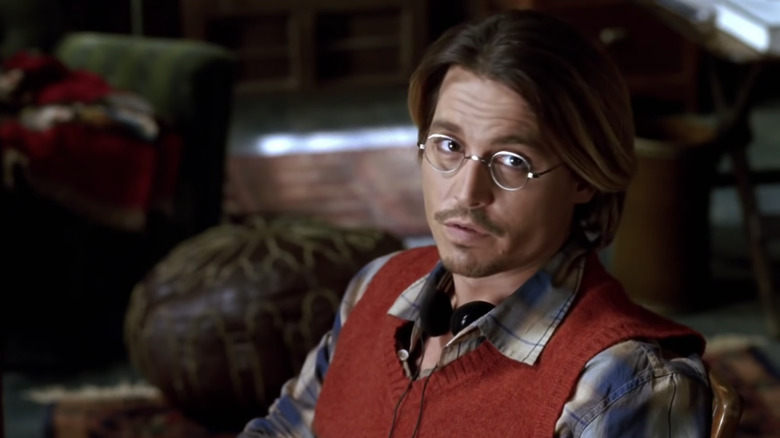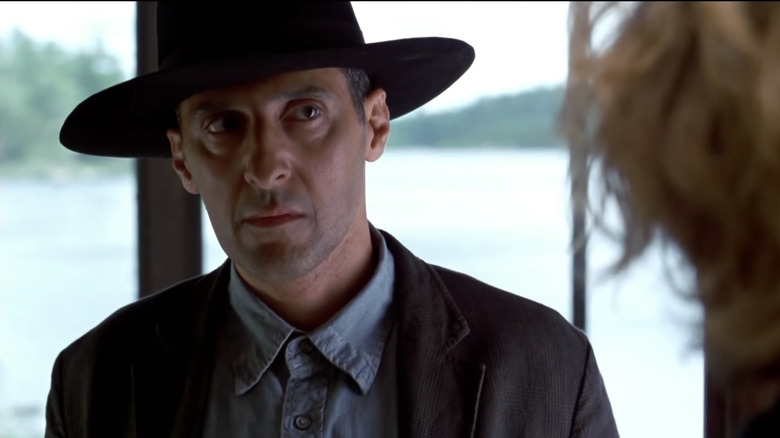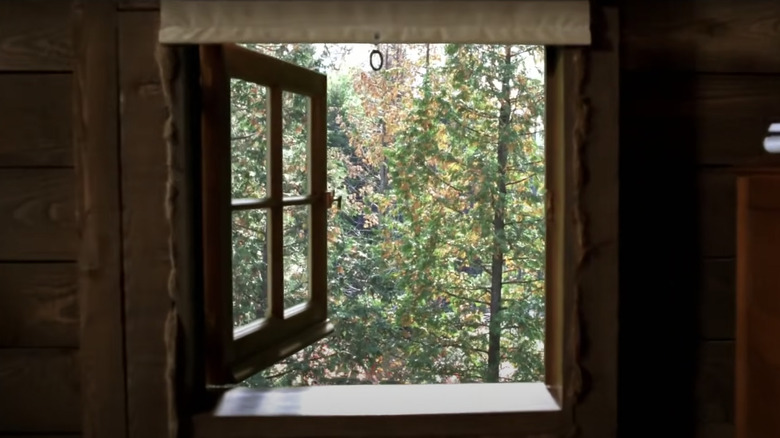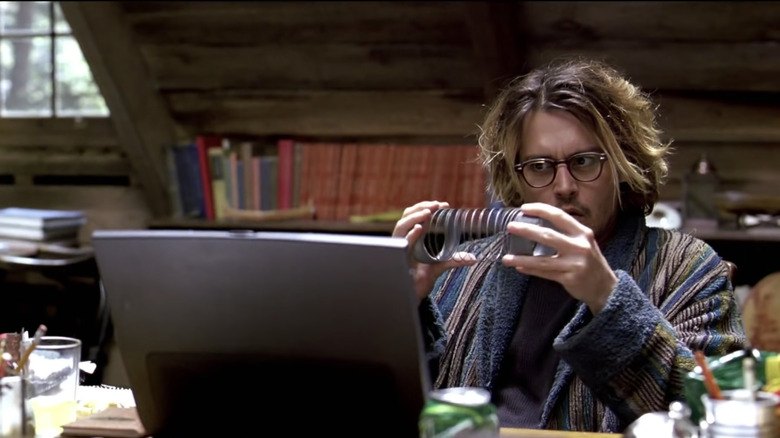The Ending Of Secret Window Explained
In the 2004 psychological thriller "Secret Window," a mystery writer is in a mental health crisis, and audiences watch as both the protagonist, Mort Rainey (Johnny Depp), and the antagonist, John Shooter (John Turturro), slowly become one chaotic and malicious individual.
Based on the novella, "Secret Window, Secret Garden," from the mind of the king of horror himself, Stephen King, and published in his 1990 anthology book, "Four Past Midnight," the movie is a complex journey into the mind of a writer whose perception of reality has become distorted after experiencing a traumatic event.
There's a lot to be unpacked from this movie. Almost everything in its imagery is there for a reason and has some form of meaning, i.e., the tattered robe Mort wears during his depressive state belonged to his wife, Amy (Maria Bello), when they were together and happy. Still, now that their marriage has fallen apart, the robe is tattered and torn, yet he can't let it go.
The symbolism grows even grander as the movie comes to its thrilling ending, and there may be a few things that don't seem to make sense at first. However, everything, even the more unusual aspects, has a place in the storyline of "Secret Window."
Why Mort Rainey's appearance changes after the murders
Mort Rainey is a distraught writer throughout the movie, deep inside a very dark place. The majority of the movie is told from his perspective, and it will have you believe that the Mississippi man John Shooter, is seeking revenge for what he believes is the plagiarism of his story committed by Mort, but as the plot unfolds, we realize that no one sees Shooter aside from Mort himself. His appearance reflects his mental state with a tattered robe and disheveled, unkempt hair. However, after killing Amy and her new partner Ted (Timothy Hutton), this drastically changes.
Mort's attire and attitude become very put together and distinguished. His hair is perfectly styled, and there's one significant addition that wasn't there for the rest of the film. Mort Rainey has a new set of braces after killing Amy and Ted.
When Mort is experiencing the difficulties of withholding Shooter, he clicks his jaw in a way that almost appears painful. However, his clean-cut state at the end of the film, along with his braces, indicates that he no longer needs to hold back and resort to his aggressive jaw clicks, as Shooter is now the one and only version of Mort that exists. Even when the Sheriff enters the cabin to inform Mort he is no longer welcome in the town, Mort presents himself as a distinguished gentleman rather than a chaotic writer type. This is because that is how Shooter presents himself regularly.
Shooter is Mort's way of escaping his own mistakes
The ending reveals that Shooter is an alternate personality created by Mort. He was more or less born out of a hat that Mort purchased when he and his wife Amy were still together. The hat is an old-fashioned one that Mort and Amy have a laugh over at a market. The accent Mort imitates when playing around with the hat is the same accent he later uses for Shooter's persona.
Shooter is created as a way to handle the bloody tasks that Mort can't stand, but he's created under the excuse of a plagiarism dispute. Throughout the film, we learn that Mort had previously plagiarized a story and that the guilt of that had followed him over the years. Shooter is a form of escapism for Mort that got out of control when Mort experiences a psychotic break. The persona of Shooter helps Mort deal with the part of his life that he can't emotionally handle by creating a distance between Mort and his actions.
When Mort found that Amy had been having an affair, he fell into a depression and became dangerously isolated. His bleak emotions and outlook led him to create this alter-ego and call him Shooter, meaning "shoot her." Mort's story, "Secret Window," was closely aligned with his own personal life but was published before his wife's affair. Since it was so close to his own life, he wanted to change it to better fit current events. This means that deep within his subconscious, Mort always planned to murder Amy and Ted, whether he realized it or not.
The significance of the corn and the window
The secret window itself is in the loft area of Mort's cabin, and its small and odd placement just above the floor level upstairs makes it easy to overlook. The window's view is of a small garden area on the side of the house, which Mort recalls Amy naming the "secret garden."
After murdering his estranged wife and her partner, Mort buries them under a small patch of corn he's planted in the garden from which he eats copious amounts of corn on the cob, as seen in the ending scene, and his writing begins to flourish again as his writer's block ends. The small crop of corn works slowly to hide the evidence of Ted and Amy's murders as it grows out of their decomposing bodies. The unusual placement of the window allows Mort to see his corn from a perspective that would be difficult to achieve otherwise. This perspective could be the key in finding a new ending to his story, "Secret Window."
Stephen King says it best himself in an explanation of his inspiration for the original story. "Sitting down at the typewriter or picking up a pencil is a physical act; the spiritual analogue is looking out of an almost forgotten window, a window which offers a common view from an entirely different angle ... an angle which renders the common extraordinary," he wrote. "The writer's job is to gaze through that window and report on what he sees." As Mort's perspective changes, so does his mental clarity and the ending of his story.
The novella and the movie have different endings
The movie is an adaptation of a Stephen King novella and for the most part, covers all the bases of the storyline. Shooter takes the place of Mort for the more grisly tasks of arson and murder, but Mort separates himself so much from these crimes that he sees Shooter as not only a different person entirely but a threat to his own life. However, as is expected, there are a few differences between the movie and the novella.
In the novella, King invites readers into the mind of Mort, and most of the conflict takes place within Mort's own head, including his initial decision to go to the police. The film broadens this into a more open viewpoint and shows Mort seeking help from outside sources without as much hesitation.
The gruesome end to the film is well-done, but not exactly true to the original story. In the movie, Mort is left eating the corn grown from the corpse of his past love, in King's version, he doesn't get that chance. Instead, when he reveals to Amy that he's had a mental break and tries to kill her, she is saved by an insurance agent who comes along at just the right moment and puts a bullet in Mort's head.
